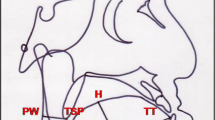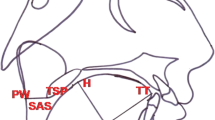Abstract
Objectives
This study aims to evaluate the potential benefits of combining tongue reduction with mandibular setback surgery in patients undergoing class III orthognathic surgery. Specifically, we investigated whether this combined approach reduced the risk of surgical relapse, condylar resorption, and airway space reduction by mitigating tongue pressure on the mandible.
Material and methods
The study retrospectively enrolled patients who had undergone bilateral sagittal split ramus osteotomy (BSSRO) with at least 5 mm of setback and met the criteria of a body mass index > 20 kg/m2 and tongue volume > 100 mm3. The study included 20 patients with 10 in the tongue reduction group (TR, n = 10) and 10 in the BSSRO only group (SO, n = 10).
Results
The volumetric changes of the total airway space were significantly different between the TR and SO groups (p = 0.028). However, no significant differences were observed in the condylar resorption and postoperative relapse between the groups (p = 0.927 and 0.913, respectively). The difference between the resorption of the anterior and posterior segments of the condyle was also statistically insignificant (p = 0.826). Postoperative counterclockwise rotation of the proximal segment only demonstrated a significant correlation with postoperative relapse (p = 0.048).
Conclusions
The reduction in tongue volume demonstrated a preventive effect on the reduction of the airway space after mandibular setback, although it did not yield statistical significance concerning surgical relapse and condylar volume. The counterclockwise rotation of the proximal segment might be responsible for the forward displacement of the distal segment and postoperative relapse. However, the clinical implications of this finding should be interpreted with caution owing to the limited sample size
Clinical relevance
Tongue reduction could potentially serve as a preventive measure in preserving the airway space and might be beneficial in mitigating the risk of obstructive sleep apnea in patients with class III deformity.





Similar content being viewed by others
References
Wolford LM, Cottrell DA (1996) Diagnosis of macroglossia and indications for reduction glossectomy. Am J Orthod Dentofacial Orthop 110:170–7
Xin N, Tao W, Ashwin DV, Jinlin S (2015) Establishment of integral biomechanical balance in the correction of tongue source skeletal dentomaxillofacial open bite deformities. J Craniofac Surg 26:473–6
Miyawaki S, Oya S, Noguchi H, Takano-Yamamoto T (2000) Long-term changes in dentoskeletal pattern in a case with Beckwith-Wiedemann syndrome following tongue reduction and orthodontic treatment. Angle Orthod 70:326–31
Giancotti A, Romanini G, Di Girolamo R, Arcuri C (2002) A less-invasive approach with orthodontic treatment in Beckwith-Wiedemann patients. Orthod Craniofac Res 5:59–63
Strîșca S (2022) 3D volumetric analysis of the tongue in patients with skeletal class III malocclusion. Moldovan J Health Sci 28:51–56
Ihan Hren N, Barbic U (2016) Tongue volume in adults with skeletal Class III dentofacial deformities. Head Face Med 12:12
Vogel JE, Mulliken JB, Kaban LB (1986) Macroglossia: a review of the condition and a new classification. Plast Reconstr Surg 78:715–23
Proffit WR, Turvey TA, Phillips C (2007) The hierarchy of stability and predictability in orthognathic surgery with rigid fixation: an update and extension. Head Face Med 3:21
Roh YC, Shin SH, Kim SS, Sandor GK, Kim YD (2014) Skeletal stability and condylar position related to fixation method following mandibular setback with bilateral sagittal split ramus osteotomy. J Craniomaxillofac Surg 42:1958–63
Reyneke JP, Ferretti C (2002) Intraoperative diagnosis of condylar sag after bilateral sagittal split ramus osteotomy. Br J Oral Maxillofacial Surg 40:285–292
Vandeput AS, Verhelst PJ, Jacobs R, Shaheen E, Swennen G, Politis C (2019) Condylar changes after orthognathic surgery for class III dentofacial deformity: a systematic review. Int J Oral Maxillofac Surg 48:193–202
de Moraes PH, Rizzati-Barbosa CM, Olate S, Moreira RW, de Moraes M (2012) Condylar resorption after orthognathic surgery: a systematic review. Int J Morphol 30:1023–1028
Hoppenreijs TJ, Freihofer HP, Stoelinga PJ, Tuinzing DB, van’t Hof MA, (1998) Condylar remodelling and resorption after Le Fort I and bimaxillary osteotomies in patients with anterior open bite. A clinical and radiological study. Int J Oral Maxillofac Surg 27:81–91
Ahn SH, Kim J, Min HJ, Chung HJ, Hong JM, Lee JG, Kim CH, Cho HJ (2015) Tongue volume influences lowest oxygen saturation but not apnea-hypopnea index in obstructive sleep apnea. PLoS One 10:e0135796
Hotwani K, Sharma K, Jaiswal A (2018) Evaluation of tongue/mandible volume ratio in children with obstructive sleep apnea. Dental Press J Orthod 23:72–78
Jung J, Kim JH, Lee JW, Ohe JY, Choi BJ (2018) Three-dimensional volumetric analysis of condylar head and glenoid cavity after mandibular advancement. J Craniomaxillofac Surg 46:1470–1475
Ueyama Y, Mano T, Nishiyama A, Tsukamoto G, Shintani S, Matsumura T (1999) Effects of surgical reduction of the tongue. Br J Oral Maxillofac Surg 37:490–5
Swennen G (2017) 3D virtual treatment planning of orthognathic surgery. Springer, Berlin
Komori E, Aigase K, Sugisaki M, Tanabe H (1989) Cause of early skeletal relapse after mandibular setback. Am J Orthod Dentofacial Orthop 95:29–36
Petdachai S, Inoue Y, Inoue H, Sakuda M (1993) Orthognathic surgical approach and partial glossectomy to a skeletal 3 adult open bite. J Osaka Univ Dent Sch 33:14–20
Chatzistavrou E, Kolokitha OE, Topouzelis N (2012) A severe open bite case treated with orthodontics and tongue reduction surgery: 13-year followup A case report. Aust Orthod J 28:94–103
Tanaka OM, Guariza-Filho O, Carlini JL, Oliveira DD, Pithon MM, Camargo ES (2013) Glossectomy as an adjunct to correct an open-bite malocclusion with shortened maxillary central incisor roots. Am J Orthod Dentofacial Orthop 144:130–40
On SW, Han MW, Hwang DY, Song SI (2015) Retrospective study on change in pharyngeal airway space and hyoid bone position after mandibular setback surgery. J Korean Assoc Oral Maxillofac Surg 41:224–31
Sahoo NK, Agarwal SS, Datana S, Bhandari SK (2021) Effect of mandibular setback surgery on tongue length and height and its correlation with upper airway dimensions. J Maxillofac Oral Surg 20:628–634
Kawakami M, Yamamoto K, Noshi T, Miyawaki S, Kirita T (2004) Effect of surgical reduction of the tongue on dentofacial structure following mandibular setback. J Oral Maxillofac Surg 62:1188–92
Poddebniak J, Zielnik-Jurkiewicz B (2019) Impact of adenoid hypertrophy on the open bite in children. Otolaryngol Pol 73:8–13
Bouwman JP, Kerstens HC, Tuinzing DB (1994) Condylar resorption in orthognathic surgery. The role of intermaxillary fixation. Oral Surg Oral Med Oral Pathol 78:138–41
Iguchi R, Yoshizawa K, Moroi A, Tsutsui T, Hotta A, Hiraide R, Takayama A, Tsunoda T, Saito Y, Sato M, Baba N, Ueki K (2017) Comparison of temporomandibular joint and ramus morphology between class II and class III cases before and after bi-maxillary osteotomy. J Craniomaxillofac Surg 45:2002–2009
Nunes de Lima V, Faverani LP, Santiago JF Jr, Palmieri C Jr, Magro Filho O, Pellizzer EP (2018) Evaluation of condylar resorption rates after orthognathic surgery in class II and III dentofacial deformities: a systematic review. J Craniomaxillofac Surg 46:668–673
Wang Z, Shi Y, Wang Y, Chen W, Jiang H, Cheng J (2023) Three-dimensional quantitative changes of condyle in patients with skeletal class III malocclusion after bimaxillary orthognathic surgery with 5-year follow-up. Clin Oral Investig 27:4061–4071
Kim YJ, Lee Y, Chun YS, Kang N, Kim SJ, Kim M (2014) Condylar positional changes up to 12 months after bimaxillary surgery for skeletal class III malocclusions. J Oral Maxillofac Surg 72:145–56
Luchi GH, Conci RA, Tomazi FH, Berticelli RD, Guarenti MM, Fritscher GG, Heitz C (2017) Assessment of the postoperative stability of mandibular orthognathic surgery for correction of class III skeletal malocclusion. J Craniofac Surg 28:151–156
Satiroglu F, Arun T, Isik F (2005) Comparative data on facial morphology and muscle thickness using ultrasonography. Eur J Orthod 27:562–7
Yang HJ, Hwang SJ (2014) Contributing factors to intraoperative clockwise rotation of the proximal segment as a relapse factor after mandibular setback with sagittal split ramus osteotomy. J Craniomaxillofac Surg 42:e57-63
Arnett GW, Gunson MJ (2013) Risk factors in the initiation of condylar resorption. Sem Orthodont 19:81–88
Park SB, Yang YM, Kim YI, Cho BH, Jung YH, Hwang DS (2012) Effect of bimaxillary surgery on adaptive condylar head remodeling: metric analysis and image interpretation using cone-beam computed tomography volume superimposition. J Oral Maxillofac Surg 70:1951–9
Eggensperger N, Raditsch T, Taghizadeh F, Iizuka T (2005) Mandibular setback by sagittal split ramus osteotomy: a 12-year follow-up. Acta Odontol Scand 63:183–8
Lee K, Hwang SJ (2019) Change of the upper airway after mandibular setback surgery in patients with mandibular prognathism and anterior open bite. Maxillofac Plast Reconstr Surg 41:51
Murphey AW, Kandl JA, Nguyen SA, Weber AC, Gillespie MB (2015) The effect of glossectomy for obstructive sleep apnea: a systematic review and meta-analysis. Otolaryngol Head Neck Surg 153:334–42
Funding
This work was supported by the Ministry of Education of the Republic of Korea and the National Research Foundation of Korea (NRF-2021R1G1A1093360)
Author information
Authors and Affiliations
Contributions
Conceptualization: JJ; methodology: JJ, CBJ, OJY; investigation: BJJ, JJ; formal analysis: BJJ, JIR, JJ; writing—original draft: BJJ, JJ, OJY; writing—review and editing: OJY, JJ; supervision: JJ, CBJ.
Corresponding author
Ethics declarations
Ethical approval
The present study was approved by the Ethics Committee of the Kyung Hee University Dental Hospital (KH-DT20013).
Consent to participate
Not applicable.
Competing interests
The authors declare no competing interest.
Additional information
Publisher's Note
Springer Nature remains neutral with regard to jurisdictional claims in published maps and institutional affiliations.
Rights and permissions
Springer Nature or its licensor (e.g. a society or other partner) holds exclusive rights to this article under a publishing agreement with the author(s) or other rightsholder(s); author self-archiving of the accepted manuscript version of this article is solely governed by the terms of such publishing agreement and applicable law.
About this article
Cite this article
Jeong, BJ., Ohe, JY., Ryu, JI. et al. The effect of tongue reduction for preventing adverse effects in patients undergoing class III orthognathic surgery: a three-dimensional comparative analysis. Clin Oral Invest 28, 162 (2024). https://doi.org/10.1007/s00784-024-05554-0
Received:
Accepted:
Published:
DOI: https://doi.org/10.1007/s00784-024-05554-0




